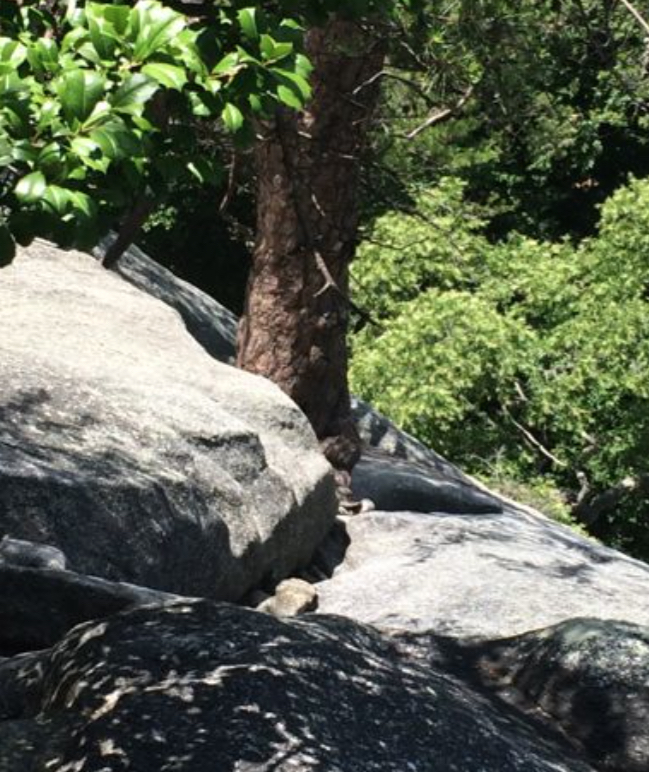Fall on Rock – No Anchor, Poor Position
North Carolina, Stone Mountain State Park
|
|
|
The two climbers were probably preparing to lower from this tree when they fell to the ground at Stone Mountain. |
Late in the afternoon on Saturday, June 7, Lisa Bacon (31) and Brian Sakofsky (35) fell approximately 60 feet from the Tree Ledge while rappelling the south face of Stone Mountain. Both sustained life-threatening injuries. Bacon was taken by an Air Care helicopter to Wake Forest Baptist Hospital, in Winston-Salem, while Sakofsky was taken by ground.
ANALYSIS
Park officials, along with members of the Carolina Climbers Coalition, conducted an investigation to determine the cause of the accident. This involved examination of the accident scene and inspection of equipment. The climbers were not interviewed.
Lisa’s harness was attached to the climbing rope by a locking carabiner through the belay/ rappel loop and a partially finished figure 8 knot tied to that carabiner. The rope had been cut a few feet above the knot, apparently by rescue personnel. This configuration suggests the climber was not tied into the rope while moving around on the Tree Ledge before attaching it to the locking carabiner. Her harness also had a belay/rappel device and a nut tool attached to the gear loops. Because the rappel device was not attached to the rope or in a position to be used, it is unlikely she was preparing to rappel at the time she fell. There were no slings or carabiners attached to her harness that would indicate that she was clipped in or able to be clipped in to a fixed anchor.
Brian’s harness was severely abraded on the leg and waist loops, most likely from sliding down the lower angle rock below the Tree Ledge. There was a personal anchor system (PAS) girth-hitched through the belay/rappel loop, a very typical set-up for clipping into anchors. The rope was not attached to Brian’s harness. An additional 48-inch sling was doubled over into a 24-inch length and clipped to the PAS with two locking carabiners. The absence of a carabiner on the end of the 48-inch sling or the PAS suggests the climber was not clipped into an anchor at the time of the fall, nor was he immediately ready to do so. One possible scenario is that Brian intended to wrap the 48-inch sling around a tree or rock and use that as anchor, but the sling likely would not have reached around the tree closest to where the fall occurred.
The top of the Entrance Crack, at the right end of Tree Ledge, was the most likely location from where the climbers fell (based on where they landed and what information the rangers had). There were no signs of an anchor on the tree at the top of the Entrance Crack, nor in the surrounding area, indicating the climbers were not secured at the time of the accident. A two-bolt anchor is located approximately 15 feet above and climber’s left of this tree, but no gear was found attached to it.
Based on the investigation, both Brian and Lisa were likely preparing to rappel or lower from the large tree located at the top of the Entrance Crack. Brian has stated that Lisa was going “over the tree” when she slipped and fell down the face, and he fell while trying to grab her. If this is accurate, this suggests that Brian likely was going to use the tree to assist in lowering Lisa, who was apparently anxious to be on the ground. Lowering a climber is fairly standard practice, however typically the rope would be passed around the tree and secured to the climber being lowered while both climbers were safely anchored to the cliff. Neither climber appears to have been anchored.
The Grigri found with Brian’s equipment was closed and attached to a locking carabiner, but not the rope, suggesting that Lisa was not on belay while moving around the tree. It is likely that Brian was preparing to put Lisa on belay when the accident occurred.
The two-bolt anchor near the accident scene is located on a small, flat ledge and is easily accessible—it is one of the primary means of descent from the Tree Ledge. The anchor location is not easily visible from above, due to the angle of the rock, but is visible when looking back up the cliff from the tree. The climbers’ 70-meter rope would have reached the ground from these bolted anchors. The climbers appear to have been unfamiliar with the area and the descent options.
In conclusion, this was an avoidable accident, with safer descent options being readily available. Most likely a combination of anxiety and a lack of appropriate edge awareness resulted in Lisa losing her balance and falling down the face. If Brian tried to grab her from his position at the top of Entrance Crack, it is easy to see how he could have lost his balance or been pulled off by her weight. (Source: Edited from a report by Brian Payst, Carolina Climbers Coalition.)



